Today’s CometWatch mosaic comprises images taken by Rosetta’s navigation camera (NAVCAM) on 21 January, from a distance of 27.9 km from the centre of Comet 67P/Churyumov-Gerasimenko. The image resolution is 2.4 m/pixel and the individual 1024 x 1024 frames measure 2.4 km across. The mosaic is slightly cropped and measures 4.2 x 4 km.
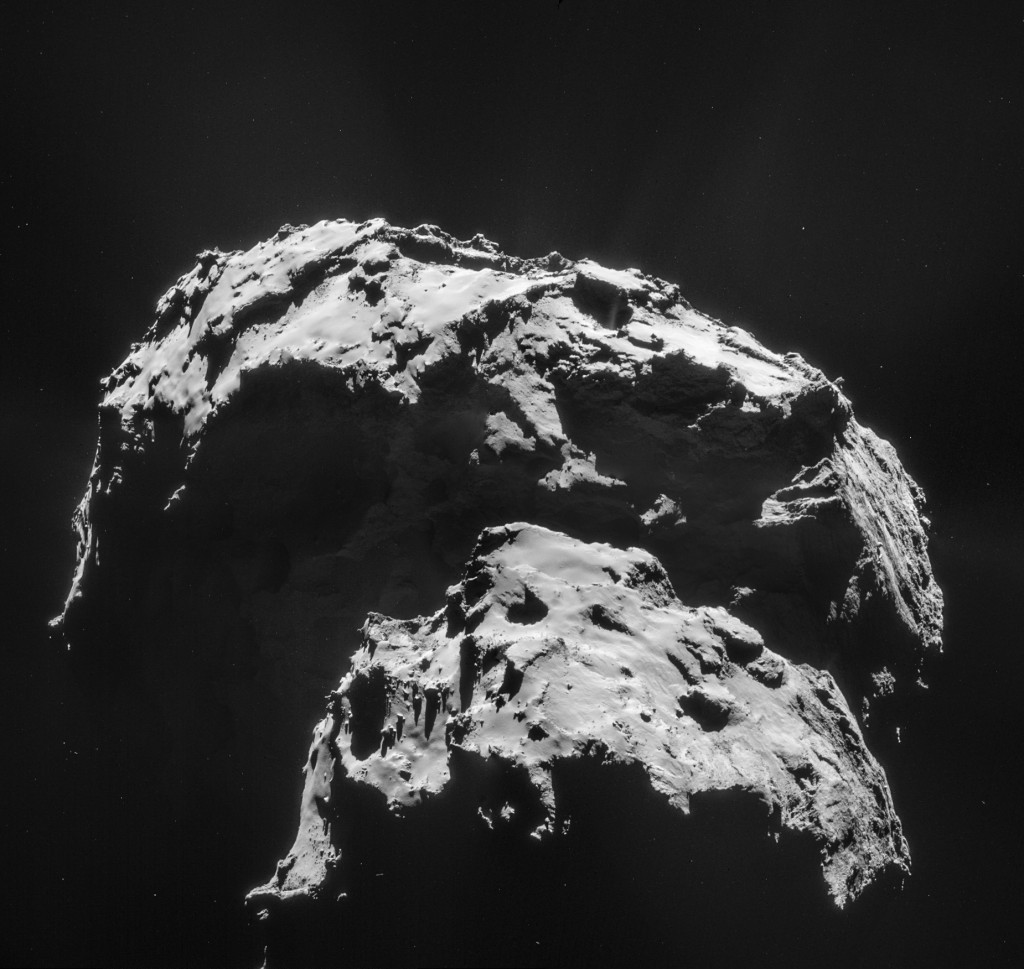
Four image mosaic comprising images taken on 21 January 2015 by Rosetta’s Navigation Camera (NAVCAM). Rotation and translation of the comet during the imaging sequence make it difficult to create an accurate mosaic, and there may be some spurious spatial and intensity features as a result of the mosaic-making sequence, so always refer to the individual frames before performing any detailed comparison or drawing conclusions about any strange structures or low intensity extended emission. Indeed, for this image set, the feature near the centre of the mosaic is a compromise of the top two frames. Credits: ESA/Rosetta/NAVCAM – CC BY-SA IGO 3.0
In this orientation we see the small comet lobe in the foreground and the large lobe in the background, with the overall view giving the appearance that the duck-shaped comet is lying down on its side. The small lobe presents the Baset (right) and Ma’at (left) regions, while the body includes Khepry (the seemingly flat edge at the far right), and the dust-dominated Babi and Ash regions. (Click here for a useful region map.)
Looking particularly dramatic in this view is the raised plateau close to the far horizon, just right of centre. Zooming in to its edge reveals crevice-like features that appear similar to those identified in the Seth region as precursors to collapse. Don’t miss the bright emission that is contrasted against the shadowed wall of this feature, too!
You might also like to ramp up the contrast to bring the Seth region out of the shadows.
The four 1024 x 1024 pixel images making up the mosaic, along with a montage, are provided below:

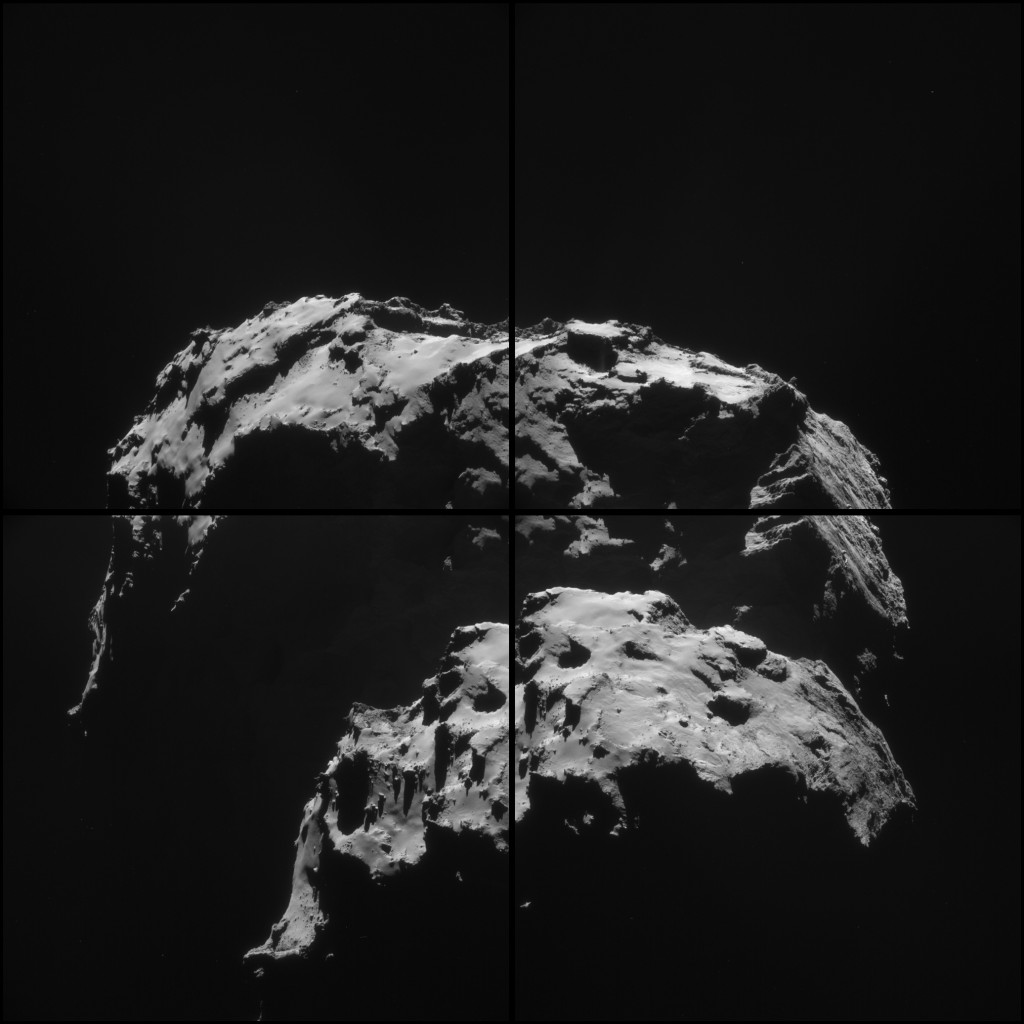
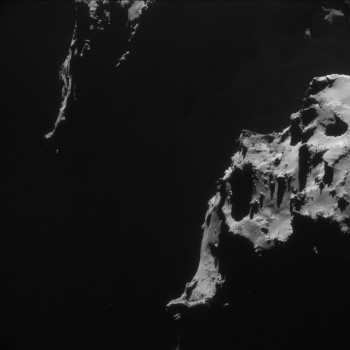
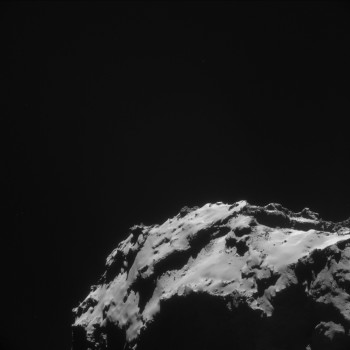
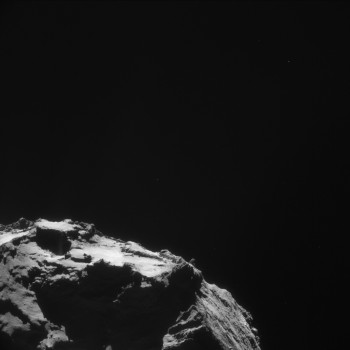
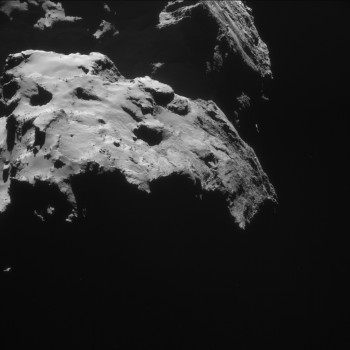








Discussion: 30 comments
Hi Team,
Excellent mosaic!
Please note that the following link (that you mention) in the article is not working: https://www.esa.int/spaceinimages/Images/2015/01/Getting_to_know_Rosetta_s_comet_region_maps%5D%20for%20a%20useful%20region%20map
Thanks!
I see what’s happened there! Fixed now – thanks for flagging!
Thanks again Emily for this image from yet another different viewpoint. I note that on the bottom left of the head lobe, in the Ma’at region, there is an alternative view, from the opposite side, of the formation seen in the OSIRIS image used for the cover of Science.
https://www.esa.int/spaceinimages/Images/2015/01/Comet_from_8_km
It is noticeable how similar this formation is to many others on 67P, in particular the larger “basin” of Hatmehit seen in the Jan 18th image. I can imagine, given what we know so far, a possible scenario for the erosion of a circular scarp to give the current appearance of these formations, but how these cliffs or mountain ridges are formed still evades me. Their scale makes it difficult to imagine sublimation is involved, and impacts making that size of dent in the comet, given its porosity, would surely have smashed it to pieces.
One plausible suggestion might be large scale voids beneath the surface and their collapse. This just moves the problem on to the mechanisms for the development of such voids in the past.
Another mechanism may be due to internal mass loss and the subsequent contraction in volume of the comet. This could lead to fracturing and buckling of the sintered ice sub-surface crust, which gives the appearance of being relatively hard and solid, but brittle. Certainly the large scarps and mountain ridges in the Ash area near Cheops look to be formed in this way and the OSIRIS team suggest there is evidence for such tectonic forces. Again, how do you loose such large amounts of mass from well below the surface and sub-surface of the comet?
Any other ideas out there?
Hi Robin
I have an explanation for all the cliff/mass loss areas you desribe, especially Hatmehit and Imhotep. This link deals with Hatmehit and then follows onto Imhotep.
https://scute1133site.wordpress.com/2015/01/25/180/
Hi Robin, yes there is other ideas out there, and they are very compelling. Every time I have made a link to where it is explained in detail, my comment hasn’t passed moderation.
A pair of posts by A. Cooper goes into details about how Hatmehit and Imhotep were formed, including the cliffs, scarps and flat bottoms. Find them if you can.
Thanks Marco and A. Cooper. I have been following your ideas, but had not caught up with Number 12. There are a number of what look like fracture planes at various points on the comet, but the homogeneous nature of the comet material leads me to think they could also be the result of rapid erosion during closest approaches to the sun. Many of them are highly exposed during the comet’s summer.
So I find your ideas plausible, but I am doubtful about the energy budgets required for such drastic events. I do think that spin up through mass loss does have a part to play, the stresses on the apparently brittle “crust”, for want of a better word, should be evident in the topology of the surface, but maybe not to the levels you outline. The science team’s assessment that there would seem to be an energy deficit to explain the surface morphology by sublimation alone, does require exploration of other ideas, the effects of spin up being one of them and past impacts another.
Impacts with solid rocky bodies are well understood, but Rosetta data seems to be showing a material composition about which there is little experimental evidence. We may have to wait for reviews of any relevant work in the past and new experiments to be carried out to properly model the behaviour of this little understood mixture of volatile ices, interplanetary dust and organics.
Hi Robin, thanks for taking the interest. I am not sure I understand some of your objections. Firstly, what do you mean when you say rapid erosion could form something that would resemble fracture planes? From what I understand of erosion, it preferentially erodes weaker substrate, so whether erosion was rapid or slow would not look like a fracture, unless the substrate was *not* homogenous.
Also regarding the energy budgets that may be required. How much energy do you think is required? How sure are we that it is even an issue? What we are broadly looking at is whether the observations fit what would be expected if the comet was spinning fast at some point. How does this compare to what we would *expect* from rapid erosion in a gravitationally bound situation. Erosion, subduction and impacts would result in phenomena that are not aligned or biased in any way in reference to the rotation plane and direction of rotation. This is of immense statistical significance if we are trying to track the cause of surface features.
Hi Robin. Following your model closely I also hit a wall when arriving at that point. Being surface crust so thermically inert and dry, most of the action has to be happening below it. So this ‘crumbling down’. But how the necessary energy budget is going under?
Also hitting a wall on commented jet ‘speeds’. I understand that molecular speed is highly related to temperature, and those speeds ‘maps’ to temperatures so high they can’t be related to surface’s ones.
No longer we can reduce these issues to thermodynamics, maybe 🙂
67P exhibits more skin [All ‘waxy’ surfaces]
Hi Emily.
“Don’t miss the bright emission that is contrasted against the shadowed wall of this feature, too!”
Could that be a sand ‘cascade’ being ‘fluidized’ down?
Thank you for pointing out that jet/emission emily. There isn’t any jet visible in the recent 8th January NAVCAM when looking at the same area, but then you also lack the shadows to contrast it against. Looking way further back in 10th October and you will find it isn’t there either ( https://blogs.esa.int/rosetta/2014/10/17/cometwatch-at-10-km/ ) despite being a very similar image otherwise, with shadows that should provide the needed contrast. Neither is it in the movie images where you also see the same area with the shadows in a similar configuration.
You could easily take this as a proof of the increasing activity of the comet and interestingly it is once again from a pit, just as the ones in the recently released scientific papers. That then just makes it even more interesting as to where the jets that were visible in Hapi valley came from and why they seemed to go sideways while the others have seemed to go straight upwards.
Thanks for finding a good “before” comparison! 🙂
Hi Daniel. These curved semi-domes above pits might play a part in the redirection of jets. We saw in this image a jet being deflected sideways by the curved overhang in the Hathor, (head cliff face), region.
https://www.esa.int/spaceinimages/Images/2014/11/Comet_on_4_November_NavCam
Looking closely at the jet in todays image, the source appears to be in front of that curved overhang, possibly from the surfaces of exposed rubble, or an area of more volatile material just below the thinning dust layer, or the inner rim of the pit, now more exposed by the change of seasons. The earlier images could have been when the shadow cast by the curved overhang prevented enough sunlight reaching the surface of the source region to generate a jet.
Is there enough evidence yet to conclude that these semi-domes we see carved in slopes and cliffs are created by the scouring of the sub-surface material away by active jets? If so why only in semi-circles or horseshoe shapes like are just starting to form in the Hapi dust plain? A careful analysis of the alignment of these “caves” to see if there is a correlation with illumination angle and energies might reveal the answer. Within a localised area they all seem to face the same way, but over larger areas, not.
True enough, the earlier image though close doesn’t have identical shadows so that may the main factor. It’s not like we can see inside the pit in these images to see how the sunlight falls there after all. If that is the case then the jet formation is very sensitive to direct sunlight though. It does hold with the earlier OSIRIS Seth pit jet, where there is (probably) direct sunlight at wherever the source is inside the pit. Which brings us back to the Hapi jets in the shadow of the “amphitheatre” once again.
NOTE! Anything from this point on shouldn’t be taken too seriously. It’s all idle speculation without anything to back it up. NOTE!
So you would perhaps get something like this:
https://i.imgur.com/Y67ilaX.png
Credits: ESA/Rosetta/NAVCAM – CC BY-SA IGO 3.0
https://creativecommons.org/licenses/by-sa/3.0/igo/
That’s from the 22nd January 2015 NAVCAM image. The yellow lines represent a potential source for the 10th January 2015 Hapi jets. A horseshoe feature is circled in black, this particular horseshoe seems to have moved towards the Hapi jet source (i.e. in the opposite direction of the jets) between 8th January and 22nd January. So in that case the horseshoes might be a direct effect of the jets blowing past the dust? It’s hard to really imagine how the jets would really interact with the dust in the vacuum of space to do this however.
If one set of horseshoes are directly made due to the direct interaction of jets, then it stands to reason that all of them should be made that way. So the source should be in the opposite direction of the open end of the horseshoe. There is fortunately another set of horseshoes nearby to test this out with, but at this point this theory seems to crumble to dust. The green and red arrows are attempts to find sources for the other chain of horseshoes, but they are much further away from their horseshoes than the yellow arrow source.
I don’t take this theory very seriously myself, but it can still be fun to speculate.
Still no sign of Philae until now. So I ask these 3 questions.
1. Is it possible that Philae can be in time covered with dust?
2. Could the hole where Philae is, become deeper in time due to outgassing?
3. Is it possible for material from surrounding cliffs to fall over Philae and cover it?
If this is the case, it shows us how dynamic comets really are.
Ana, I think if we are honest, the knowledge of the detailed properties of the comet and the processes operating, along with a lack of a detailed position, means we really don’t know! Any of those could probably happen, and so could many other things, especially as activity increases.
So keep your fingers crossed for Philae!
Ana: Now we have a detailed response from the science teams, but going back to your questions (and I am no expert):
1. Considering the time until perihelion, this seems doubtful.
2. If there is a vent near Philae that would make its life pretty eventful (and also possibly lead to demise), more than that is hard to say.
3. Again this requires some violent activity among those cliffs, which does not seem to be the case yet.
But you have posed an interesting question: how much activity do we expect on the slopes going down from Hatmehit as we head into perihelion?
I think the answer to your questions is yes in all cases, it is POSSIBLE. But that doesn’t necessarily mean that its likely!
There is evidence that some ejected dust falls back to the comet. But the depth varies and its mainly seen in flat areas- the opposite of where Philae seems to be.
The space beneath Philae could become a jet source. Whether such a jet would help or hinder is arguable. clearly if the space got deeper and Philae sunk into it, that would be bad news. On the other hand the lander team didn’t want to land near a jet because it could lift Philae off the surface again. in the current circumstances that might be good news.
And since we don’t know how high the walls surrounding Philae are, we can’t say whether Philae could be covered by falling material. The experts suggest (yes the same ones that can’t find the lander!)that the comet’s activity will increase 100 times its current level as it approaches perihelion, and some put the jet speeds at 700m per sec. how would this affect Philae? Who knows but I’m sure we’ll find out something new – that’s what these missions are all about.
Yes you are right Ana. All of those are a possibility but not a certainty. They could still find it so keep your fingers crossed. And yes comets are dynamic, maybe much more than some people think.
I would like to post this addressed to everybody and would be grateful for your comments. It is not directly relevant to todays post but very much relevant to the overall topic.
I have come up with an additional process for the production of comet water which I have not seen described or discussed elsewhere. And I do not mean additional to the ice sublimation hypothesis but additional to the proton/oxygen
combination process. It neatly brings together all the main environmental features at the surface of the nucleus and within the coma, including the electrical discharge.
It struck me that the molecules principally and consistently identified in the coma of this and other comets are carbon dioxide, carbon monoxide and water and that these are products of combustion, combustion of hydrocarbons in oxygen. If you scribble out for yourself the combustion equations for a simple hydrocarbon such as methane you will see that this is the case. It seems therefore that what we could be observing at the surface of the nucleus is a combustion reaction and that the energy to initiate it and keep it going is provided by the proton flux striking the surface at a speed of 400-500 km/second.
Hydrocarbons have been identified on the surface of this and other comet nuclei and In my opinion and the opinions of others they originate from the process by which this comet formed, and it is nothing to do with the Oort cloud.
Apart from energy and the fuel the combustion requires one other essential ingredient which is of course oxygen and in this case the oxygen is provided by the silicate of the rock, and probably other oxygen containing compounds too.
So, to summarise, protons in the solar wind current strike the surface of the nucleus releasing hydrogen and carbon from the surface hydrocarbons and oxygen from the rock and these combine in a combustion reactions to form carbon dioxide, carbon monoxide and water. Carbon monoxide is a product of incomplete combustion resulting from insufficient supply of
oxygen, as too are the dust particles, analogous to the soot in methane combustion.
These neutral combustion products along with any surplus ions and along with the dust particles would be carried away from the surface and into the coma by the plasma discharge jets and the relative proportions of each would be expected to vary according to the exact combustion conditions. This behaviour has been observed with this comet and would be expected
as a result of changing rock conditions, distribution of hydrocarbons and varying proton flux . A corollary of this is that as both the carbon monoxide and the dust are products of incomplete combustion both might be expected to decrease as the discharge energy and proton flux increased nearer the Sun and released more oxygen from the rock.
So there it is. The observed behaviour is explained by a proton induced combustion reaction at the surface of the nucleus the progress of which depends principally on the availability of oxygen at the surface. For fun I am going to call it energetic proton combustion and I think it could kill the ice sublimation idea stone dead.
I would welcome any comments and criticism. I would also appreciate a comment from Matt at ESA.
@ Originaljohn,
What is the energy of a proton travelling at 500 km/s? Is it sufficient to break a Si-O bond with a dissociation energy of 452 kilo Joules/mole?
My answer to your first question, Alembe, is I don’t know exactly. 500km/sec is however around the normally quoted typical level and normally quoted typical energy levels are 1-10 keV. Plasma temperature data is available and seems to hover around 10.e6 deg K. There are mathematical conversions for deg K to eV but I am not sure that these are valid. These are
what might be called background levels because the properties of the solar wind current can vary widely. It seems that there is scant data available. Most of the familiar figures are measured in the vicinity of Earth, for space weather purposes, and extrapolated uniformly to other parts of the solar system. I have not found any information about actual data for solar wind speeds in the vicinity of other planets or other bodies. Solar flares and CMEs of course result in
considerable increases in speed and density, whereas background speed appears to be inversely related to density. Plasma double layers can also induce very large increases in speed, to relativistic levels in some cases.
My answer to your second question is probably, sometimes. If there are combustions reactions on the surfaces of comet nuclei and the activation energy for them is provided by solar wind protons this energy would not come from background levels. If it did comets would be active all the time and we do not observe that. The activation energy would therefore be supplied by a marginal, transient event, of a type that occurs regularly. And again coronal mass ejections would be good candidates increasing both proton energy and proton current density, with large energy increases also available in double layers and large increases in current density available from Lorentz force induced plasma pinches.
My own speculative estimates based on what data is available show that at background levels in the coma of comet 67P, published by ESA, the proton energy per sq cm at the surface of a comet nucleus could be around 0.58Joules accumulated over a 10 hour period from 10.e 11 keV per second protons. With a CME increase in energy to Mega eV levels, ie a
factor of 10.e 3 and a current density increase by a factor of also 10. e 3 in a plasma pinch, an energy in the region of 500 kJoules could be accumulated at a sq cm of nucleus surface, over a 10 hour pulse period, which would not be unusual for a CME.
Thereafter a typical hydrocarbon combustion reaction would be self sustaining because the typical exothermic energy release at 800- 900 kJ/mole is well in excess of the 420 kJ/mole required to dissociate the Si-O bond. This contradicts what I said in a previous post when I was not aware of the relative energies.
Alembe, note the figures discussed relate to energy for 1 mole of Si-O. The bond dissociation energy in eV (4.68) shows that many Si-O bonds would be separated by protons with energy levels in the keV range.
So my second answer to your energy availability query is yes.
I like your choice of words. Proton combustion kills ice stone dead. There are some ideas I like in there.
The topography and dynamics of gas and dust ejection are the result of phase separation of the original material within the highest temperature domain inside the comet. The gas separated is mainly H2O together with other minor oxide (CO2, SO2, …). The solid phase, often called dust, is mainly SiO2, Al2O3, Fe2O3, CaO, MgO, K2O, Na2O and MnO. As H2O vapor and the solid phase are expelled from the orifice (orifices), the solid adheres to the nearest solid surface available (outer surface of the comet), hence eventually closing the orifice and eventually opening another when the pressure within the closed compartment can break through the weakest point of surface layer.
Details of how and why this happens and how and where it all started will be made available on this page by 15 March 2015.
At present 67P is close to conjunction with the Sun, so we can’t see it from Earth-based telescopes. Do any of the Mars spacecraft have the ability to take long exposure photographs which will be able to see it? Mars is on the opposite side of the Sun and closer to the comet.
Here are some further notes about energetic proton combustion – intermediate products and heat:
Intermediate products of hydrocarbon combustion have been observed in the coma of this comet. These are, in addition to carbon monoxide, formaldehyde, CH2O and atomic hydrogen, H. Atomic hydrogen was found close to the nucleus, distance unspecified. Molecular hydrogen, H2, would also be expected.
Atomic H can react with oxygen to give hydrogen peroxide, 2H + O2 > H2O2
—————and with sulphur to give hydrogen sulphide, 2H +S > H2S so these products might also occur in the coma, H2S if there was sulphur either in organic or rock compound form. All of these would indicate oxygen deficiency.
In controlled combustion processes where complete combustion is required it is not unusual to supply a surplus of oxygen,
as air, typically 2-3 times the stoichiometric amount. This promotes complete combustion but also results in some unconsumed oxygen in the products.
The presence therefore of either particular intermediate products or surplus oxygen in the coma would provide a good indication of oxygen availability at the combustion sites on the nucleus and allow a correlation with observed surface activity and proton flux density.
As far as I am aware no quantitative data has been reported for these products in this instance and only relative values have been published for water and carbon dioxide, and the early water rate estimates.
Although methane is the simplest hydrocarbon and the overall reaction can be expressed with a single equation, at least 20 equations would be required to represent all the intermediate combustion reactions. With more complex and mixed hydrocarbons this figure runs into hundreds. In addition multiple rock mineral sources of oxygen would add further
complication.
One other important issue is that the hydrocarbon combustion reactions are strongly exothermic, the methane reaction releasing 891 kJ/mole. This heat would be detectable near the nucleus surface. It would not, however, allow the
reaction to self sustain as the required oxygen is locked up in the rock. Continued impact of the proton flux would therefore be necessary to maintain the oxygen supply and the activity.
Detection of this heat output in the jets would discount the predicted Joule-Thopmson effect cooling.
methane freezes at 91 deg K
ethane freezes at 90.4 deg K
methane produces 55.5 MJ/kg (891 kJ/mole) ( 1 kW-hr is 3.6 MJ, 1 J is 1W per second)
ethane produces 51.0 MJ/kg or 1559.7 kJ/mole ( a mole of ethane is 30g, a mole of methane is 16g)
overall CH4 + 2O2 > CO2 + 2H2O + 891 kJ ( 1 mole) ie 891 kJ from 16g
overall 2C2H6 + 7O2 > 4CO2 + 6H2O + 3119.4 kJ ( 2 moles) ie 3119.4 kJ from 60g
Each comet accounts for millions of kilograms of hydrocarbons and billions of kilograms of rock, and it is of little importance what is in the interior, with respect to activity. Rather than cold lumps of sublimating ice it looks as
though we are observing electric furnaces converting Mega or even Gigawatts of energy.
@ Originaljohn
“One other important issue is that the hydrocarbon combustion reactions are strongly exothermic, the methane reaction releasing 891 kJ/mole. This heat would be detectable near the nucleus surface”.
I have already draw attention on another thread to the extraordinary VIRTIS images showing surfaces temperatures which, during Fabrizio Cappacioni’s presentation at the AGU meeting, were simply flashed up on the screen for a few seconds, with virtually no comment: https://virtualoptions.agu.org/media/P32B-07.+Rosetta+2014+I%2C+Presented+By+Fabrizio+Capaccioni/0_eb9d69c6
They clearly show a fairly straight, unbroken line of considerably higher temperatures all along Hapi valley and a similarly extensive area spreading all along the base of the towering Seth cliff. (They are presented as of 4:20 into the video and you have to be really quick on the freeze-frame button to study individual images).
Since these are precisely the areas where the vast majority of the jetting activity is focused, there seems to be an obvious connection between the extra heat detected and electric discharge activity, particularly since these are also precisely the areas which receive the least sunlight on the whole comet to induce any alleged sublimation of ice.
I had assumed the higher temperatures came from electric discharges directly heating the surface rocks (for example, the line of boulders along the centre of the neck and the bottom of the Seth rock-face). But they would also tie in very well with the exothermic reactions you speak of, since that “hot band” along Hapi valley is completely continuous, suggesting the extra heat might also be coming from the carbon-rich surface of the smoother areas.
My take on this mosaic:
https://www.flickr.com/photos/105035663@N07/16416686086/in/photostream/
Contrast increased to show details on the shadowed wall:
https://www.flickr.com/photos/105035663@N07/16416703056/in/photostream/